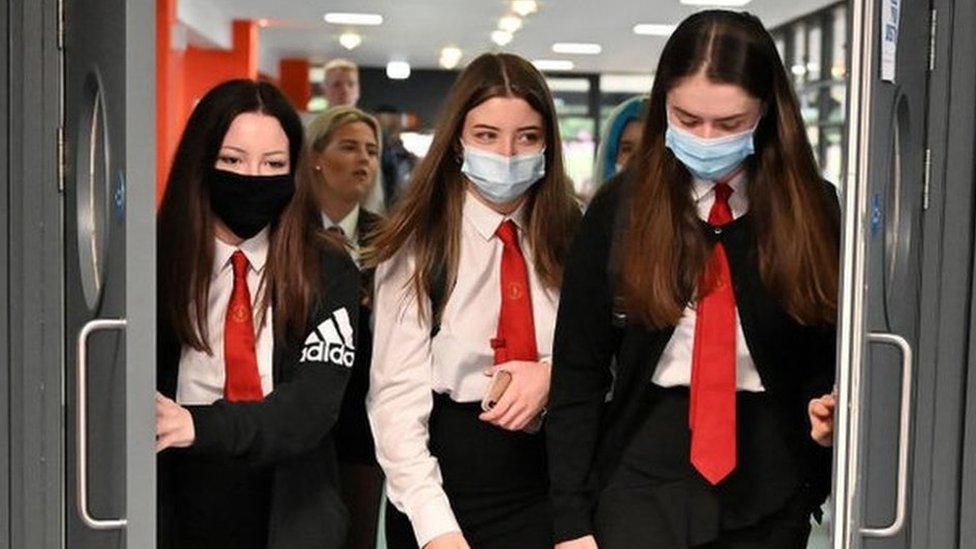Coronavirus: Can schools afford Covid costs?
- Published

More schools across the UK have started to open fully for the first time since March.
To keep pupils and staff safe, they are having to make their buildings Covid-secure as well as providing catch-up help for students who may have struggled with learning during lockdown.
All of this takes money, so how much will it cost and is government funding reaching the right places?
The cost of making schools safe
Government guidance says schools in England should implement, external a number of hygiene and safety measures to help stop the spread of Covid-19.
These range from staggered class times to deep-cleaning of buildings and access to hand sanitiser.
A survey by the National Association of Head Teachers found, external many schools have already incurred costs in the period to September, including:
Two-thirds of schools had paid additional staff costs for cleaning
Half of schools were purchasing or renting hand-washing stations
Almost all had purchased additional cleaning supplies
Around 85% of schools had purchased signage, tape or barriers
These costs came to an average of £9,990 per school (from the 1,821 responses received). However, schools also estimate a £16,000 loss of income from sources such as renting rooms or after-school clubs.
Research from the National Foundation for Educational Research (NFER) estimates , externalthat the longer-term costs for this academic year could end up being far higher.
This is because a larger number of students are returning in September, which means more staff and cleaning are required.
The research, based on responses from 500 school leaders most concerned about the viability of opening their schools, who were able to provide estimates, suggests:
Primary schools could spend an average of £280,000 per school throughout the year - or around 20% of an average local authority school's budget
Secondary schools could spend £720,000 per school - or 12% of an average local authority secondary school budget
In England, the government offered grants of up to £75,000, external depending on the size of the school for the period of March to July.
This was mainly aimed at helping schools stay open over Easter and extra support for the government's free school meals scheme. Additional cleaning could also be covered but loss of income couldn't.
From September, schools will be expected to pay for any additional costs from their existing budgets. This includes any additional staff and cleaning costs that need to be covered.

Unions have already warned this could be difficult to cover given that many schools are in a financial deficit. In 2018-19, 8% of primary schools and 28% of secondary schools were in deficit.
In Wales and Scotland, at least £20m has been put aside in each country to help schools cover cleaning costs.
On Tuesday, Schools Minister Nick Gibb said the need for additional funding was being kept under review.
Cost of catching up
Schools will also get access to £1bn of funding - which must be spent on "catch-up" activities.
This is mainly made up of a per-pupil cash boost worth £650m, meaning each primary and secondary pupil will receive £80 - in other words, a school of 200 students will receive £16,000.
Schools are being encouraged to spend the money on activities such as one-to-one tuition and extended school times.
The rest of the money, worth £350m, is aimed at giving disadvantaged students subsidised tutoring.

SCHOOLS: Which are re-opening, when?
SOCIAL DISTANCING: What are the rules now?
LOOK-UP TOOL: How many cases in your area?

However, the scheme has been criticised for not targeting students who most need the money.
Under the £650m "catch-up" scheme, children from the wealthiest areas will receive the same as those in the poorest despite the large gaps in access to education throughout lockdown.
In May, the Education Policy Institute recommended, external that any increases to per-pupil funding should mainly target those in exam years from less affluent backgrounds.
This is because children from disadvantaged backgrounds have the most catching up to do.
Analysis from the Institute for Fiscal Studies suggests, external a large gap emerged in learning hours during lockdown.

On average, the richest primary school pupils had over an hour extra learning time a day compared with the poorest pupils - creating a gap that previously didn't exist. For secondary school pupils, the difference in learning hours remained broadly the same as before.
In the event of a local lockdown, individual schools will be responsible for ensuring pupils' continued learning.
The government has so far supplied more than 200,000 laptops, external to disadvantaged pupils, and plan to deliver 150,000 more.
However, the NFER research points out that the average primary school has needed to spend £9,500 on IT provision and the average secondary school £20,000. These costs, once again, disproportionately hit less affluent schools because wealthier schools already had systems in place.
The government says costs can be managed through additional funding given to schools this year as a part of a three-year settlement worth £7.1bn by 2022-23.
However, the Educational Policy Institute has previously pointed out that this funding benefits more affluent areas, external.


